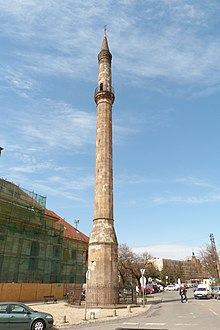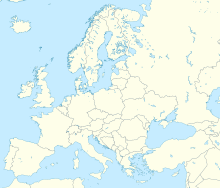 Eger minaret in 2013. | |
| Alternative name | Egri minaret, Török-kori minaret, Kethüda minaret |
|---|---|
| Location | Eger, Heves County, Hungary |
| Region | Northern Hungary |
| Coordinates | 47°53′56″N 20°22′29″E / 47.89902°N 20.37470°E |
| Type | Minaret, Monument |
| Part of | Djami of Kethuda mosque[1] |
| Height | 40 m (131 ft) |
| History | |
| Material | Red sandstone |
| Founded | Early 17th century |
| Abandoned | Yes |
| Cultures | Islamic culture |
| Site notes | |
| Excavation dates | 2018[1] |
| Condition | Preserved |
| Public access | Yes |
| Architecture | |
| Architectural styles | Ottoman architecture |
The Eger minaret (Hungarian: Egri minaret or Kethüda-minaret)[2][3] is an Ottoman-era minaret tower located in Eger city, northern Hungary. It is one of the most northern minarets left from Ottoman rule in Europe. The minaret is 40 metres (131 feet) high and built from red sandstone. It was built in the early 17th century as part of the Djami of Kethuda mosque[1][4] and used for the Muslim call to prayer (Adhan). The mosque no longer exists, but the minaret survives as a preserved monument of Hungary and a major tourist attraction of Eger. There are 98 steps on the spiral staircase inside, which leads to a balcony at 26 meters from the ground, offering unique views of the surrounding city.[2][5][6]
The Eger minaret is one of three surviving Ottoman-era minarets in Hungary. It is the highest and the best preserved of the three. The other two minarets are the Érd minaret and the minaret of Yakovalı Hasan Paşa Mosque in Pécs.[5] In 2016, a Turkish Muslim resident of Eger was permitted to call the Muslim prayer from the minaret balcony after 327 years.[7]
- ^ a b c Cite error: The named reference
a6was invoked but never defined (see the help page). - ^ a b "Minaret Eger website". minareteger.hu. Retrieved 26 September 2018.
- ^ "Torok Kori Minaret". tripadvisor.com. Retrieved 26 September 2018.
- ^ "Muslim visitor guide to Eger Hungary". halaltrip.com. Retrieved 26 September 2018.
- ^ a b "The Eger Minaret". ieger.com. Retrieved 26 September 2018.
- ^ "Minaret". visiteger.com. Archived from the original on 26 September 2018. Retrieved 26 September 2018.
- ^ Cite error: The named reference
a5was invoked but never defined (see the help page).

